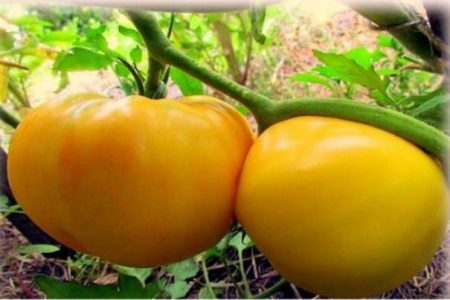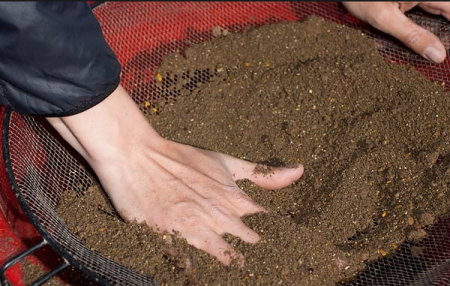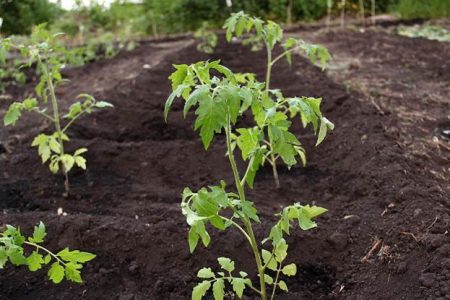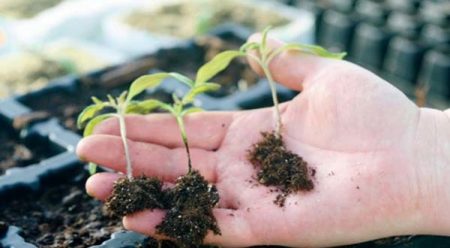 Many gardeners are engaged in the cultivation of early ripe varieties of tomato. And this is not casual - in many regions of our country it is quite difficult to grow other varieties, which the climate greatly “contributed” to. Cold weather simply “kills” the stands. But, a kiss Grandma’s kiss (yellow) can develop perfectly even in conditions of extreme cold. Before you start growing it, you should read about its features, and planting secrets.
Many gardeners are engaged in the cultivation of early ripe varieties of tomato. And this is not casual - in many regions of our country it is quite difficult to grow other varieties, which the climate greatly “contributed” to. Cold weather simply “kills” the stands. But, a kiss Grandma’s kiss (yellow) can develop perfectly even in conditions of extreme cold. Before you start growing it, you should read about its features, and planting secrets.
Content
Main technical characteristics of the variety
Variety Grandma's kiss refers to the early ripening. So, the first crop can be obtained only 100 days after planting the berries. This variety has high bushes - they can grow up to 1 m. Therefore, the gardener will have to take care of the garter of the plants so that they do not break.
The main advantage of this tomato is the amazingly beautiful fruits that grow yellow. They have a rounded, slightly flat shape, on the surface - slightly granular. Each growing tomato is quite large - it can weigh up to 500 grams.
The tomatoes are fleshy and juicy, therefore, they are often used for cooking various vegetable salads. Due to their large size, it is very inconvenient to preserve them, but there is a solution - cut the tomato into several parts.
How to plant
Gardeners recommend starting to plant this variety in early spring, so that by summer the seedlings can be dived into the ground. The planting process itself is divided into several stages.
Preparing planting material
Seeds must be properly treated before planting. For the growth process to be as fast as possible, they need to be slightly wetted. To do this, it is best to use small fabric bags. Seeds are distributed in them, wetted, and left for 12 hours. Every 2 hours, the fluid is changed.
Land preparation
Many novice gardeners believe that in order to germinate seedlings, it is necessary to use exclusively mineral-rich land. In reality, this is not so at all. It is better to take the soil with small admixtures of useful minerals, since this seedling requires a little different personal care.
Planting material needs to be planted in a mixture of earth from sand and sawdust. It will contain the necessary amount of substances necessary for the normal development of the plant.

Disembarkation
Once the planting material has sprouted, and the soil has been prepared, you can begin to plant seedlings. The best option for the planting capacity - small slides from the ground - this will in the future seriously simplify the process of planting tomatoes in open ground.
The pits for planting should have a depth of about 2 cm. Next they need to be sprinkled with soil residues, and pour plenty of water. Then the plants go to a warm, bright place for active development. If there will be little sunlight, the stems will be very weak. Therefore, for 24 hours, seedlings should be lit for at least 14 hours.
Transplant to the ground
The procedure can be started when the night frost completely stops. If the temperature is very low, the plants will simply die.
How to choose a site
It is important to choose the most optimal place for planting seedlings, because it will depend on it the future productivity. Tomato is a plant that loves heat, therefore, and the place in the garden should be appropriate.The southern part will be completely perfect.

Land preparation
Soil preparation for planting should begin to be engaged in the fall. The earth should be systematically fed with organic and mineral fertilizers, as well as dug.
Immediately before planting, potassium-based fertilizers, mineral compounds and superphosphate should be added to the soil.
Landing
The pits for planting should have a depth of about 13 cm. So that in the future the bushes do not "interfere" with each other, a distance of 40-50 cm should be maintained between them. After the formation of the pits, plants are placed in them and sprinkled with earth. After that, with the formation time, the tomatoes will have to be tied up.
Pest and disease resistance
A variety can become infected with a disease such as a black leg. The neck of the root crop gradually begins to acquire a dark color, and rots. To prevent this, it is enough to reduce watering and water the bushes with Fitosporin.

From the mosaic, the plant is also not “insured”. Pathology is manifested in the form of twisting of leaves, the appearance of rotted sections on them. You can fight in one way - to root out the affected bushes, and destroy.
Most pests tomato Grandma’s kiss is not afraid. But, it is worth making sure that the scoop “attacks” the plant. She can nibble stems and leaves. Therefore, the bushes need to be inspected from time to time, and manually remove these insects.
Reviews and recommendations of gardeners
Anatoly Nikolaevich, 32 years old, Siberia
“This variety can become infected with late blight and septoria. Already repeatedly proved both by me and my neighbors in the country. But, you can use a folk remedy to combat the disease: chop 200 grams of garlic and pour a couple of glasses of boiling water, leave for 24 hours, strain it, pour into a bucket of water. Then add 1 gram of potassium permanganate. Treat plants with a sprayer every 2 weeks "
Elena Petrovna, 29 years old, Moscow Region
“I also want to share a secret - if the seedlings have grown too large, then I plant it in this way. I dig a hole of suitable depth, pour half a bucket of water into it, wait until it is absorbed. In this “swamp” I deepen the roots of the plant, then I twist the stem in a circle in the same pit, and fill it with soil. I do everything in such a way that about 20 cm remain above the ground. Stalk. Sheets should not be torn off - they themselves will be driven away. But the stem will give additional roots under the soil. This method can even strengthen the plant. "




 Low-growing tomatoes, without pinching: 5 of the most delicious varieties
Low-growing tomatoes, without pinching: 5 of the most delicious varieties Why tomato seedlings grow poorly
Why tomato seedlings grow poorly We grow a tomato in a shell
We grow a tomato in a shell Growing tomatoes without watering according to the method of Kazarin
Growing tomatoes without watering according to the method of Kazarin